FEATURED AND RECENTLY ADDED FOSSILS
Naziv vsebine
late palaeozoic Sedimentary Evolution of the Southern Karavanks
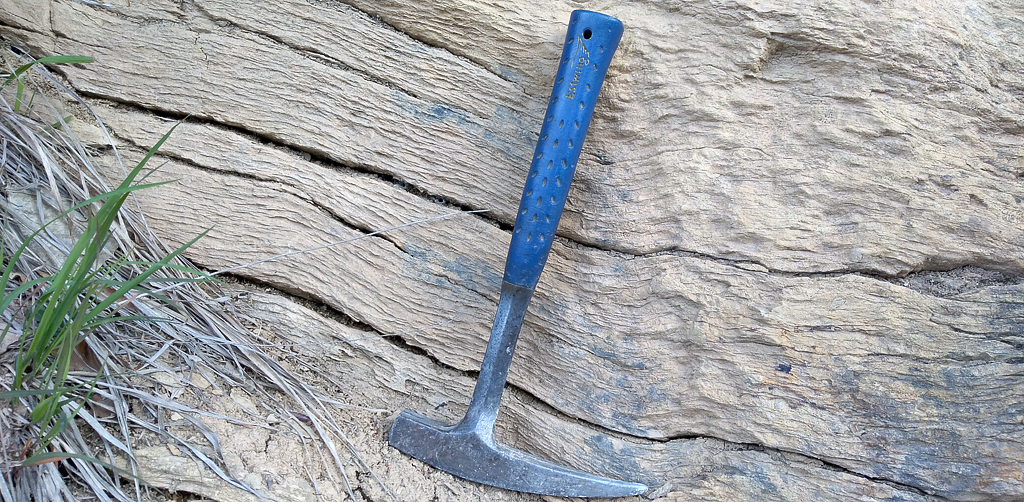
Wavy-lenticular stratification in Late Permian/Early Triassic dolostone succession due to pressure-induced interstratal dissolution. The central Southern karavanks.
The Late Palaeozoic sedimentary evolution of the Southern Karavanks and Carnic Alps, spanning from the Middle Ordovician to the Permian-Triassic boundary, is characterized by the collisional uplift of the Variscan orogenic belt, reaching its climax in the Moscovian. The pre-Variscan basement is unconformably overlain by a post-Variscan sequence, separated into two evolutionary cycles by a major intra-Permian tectonic event. Sediments from the Middle Ordovician to the early Late Carboniferous, affected by the Variscan orogeny, are overlain by coastal to shallow marine siliciclastic-carbonate sediments from the Late Carboniferous era. Early Permian witnessed the commencement of carbonate-dominated marine shelf sedimentation (Rattendorf and Trogkofel Groups), interrupted by a phase of uplift and erosion. This was followed by a new transgressive sequence featuring the red-beds of the Groden Formation and the dolomites and evaporites of the Bellerophon Formation in the Late Permian.
Pre-Variscan Evolution (Middle/Late Ordovician to early Late Carboniferous)
The Southern Karavanks represent orographic and morphological continuation of the Carnic Alps (Diener, 2002). The lithologic similaritiy and location south of the Periadriatic fault system implies a similar palaeolatitudinal setting of both regions (Hubmann et al, 2014), comprising two Palaeozoic sequences separated by a major uncoformitiy caused by the Variscan orogeny. The Prevariscan units of the Carnic Alps (Middle Ordovician – early Late Carboniferous) and Southern Karavanks (Late Ordovician – early Late Carboniferous) were deposited throughout the Ordovician on the peri-Gondwanan shelf in the southern realm of the Rheic Ocean, which expanded at the expense of the Iapetus and Tornquist Oceans as the northern-Gondwana-derived microcontinents e.g. Avalonia drifted northwards toward Baltica and Laurentia. After the closure of the Tornquist Ocean by accretion of Avalonia to Baltica in the Late Ordovician, and of the Iapetus Ocean by the collison in the Silurian of Laurentia with Baltica-Avalonia, leading to the formation of Laurussia, palaeogegraphic affinities of the present day alpine Carnic Alps and Southern Karavanks became more vague.
Two end-member models of the evolution of European Prevariscan units south of the former Avalonian margin of Laurussia, including those of the Alpine domain, have emerged. These units represent either 1.) individual or composite terranes that rifted away from Gondwana or 2.) remained attached to the northern Gondwanan margin throughout the Paleozoic.
1a: In one vantage point of the first model, a train of composite terranes, e.g. Armorican Terrane Assemblage and Proto-Alps, rifted away from Gondwana by the Late Ordovician and successevely accreted to the Avalonian margin of Laurrusia at various times in the Palaeozoic, prior to the final collision between the two major conitents in the Late Carboniferous (Tait et al., 2000, Schaetz, 2004). The drift was accompanied by the gradual replacement of the endemic faunas of the departed terranes by those of Baltic and Avalonian affinities (Schonlaub & Histon, 1999; 2000).


Fig. 1: Early Ordovician to Late Carboniferous drift history of the Gondwana-derived continental fragments, highlighting Protoalps in red. (after Schaetz, 2004).
1b: According to the second perspective, a vast ribbon-like terrane assemblage (superterrane) split off from Gondwana in the Siluro-Devonian instead of a series of terranes,colliding in the Late-Devonian-Carboniferous with the Laurussia-derived fragments and eventually Laurussia itself (Stampfli et al., 2002); von Raumer & Stampfli, 2008).
In a now abandoned scenario, the Prevariscan sequence found in today's Carnic Alps and Southern Karavanks was believed to have been deposited on the Palaeotethyan shelf at the trailing edge of the European section of the Hun superterrane (Stampfli et al., 2002) (Fig.2), which itself split off from Gondwana in the Silurian. The speculated driving force behind the drift of the Hun superterrane was Rheic slab rollback, while slab pull triggered back-arc spreading along the Laurussian margin. However, the term "Hun" now refers to another terrane detached simultaneously with Avalonia, later accreted to the North China block.
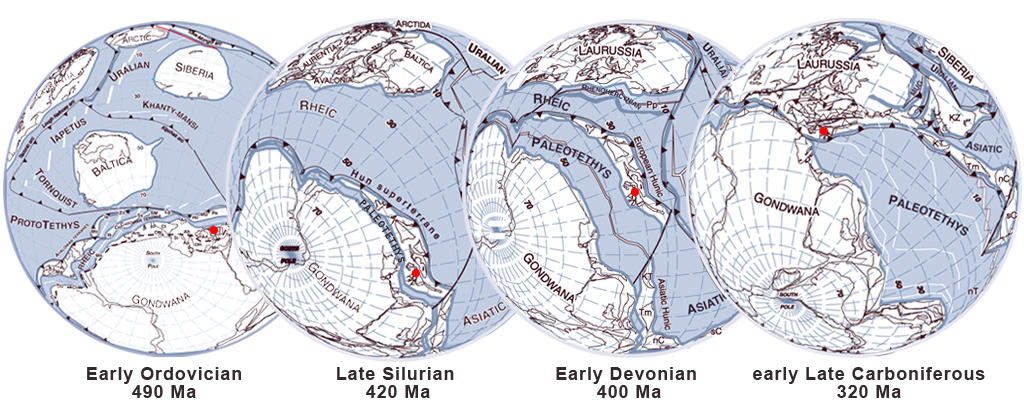
Fig. 2: Early Ordovician to Late Carboniferous drift history of the Gondwana-derived continental fragments. The red dot indicates the approximate position of the Carnic Alps and Southern Karavanks (after Stampfli et al., 2002).
In the more recent model, the dual polarity of subduction and slab-rollback on both sides of the Rheic ocean led to back-arc spreading along the opposing margins of the ocean in the Devonian. Ribbon-like continents, termed the Galatian Superterane and the Hanseatic terrane, detached from northern Gondwana and Avalonian margin of Laurussia, respectively.At the onset of rifting in the Middle Devonian, the Galatian Superterrane was flanked by the Rheic Ocean to the north. Following its separation from Gondwana in the Late Devonian, it defined the boundary between the passive-margined Palaeotethys and the active-margined Rheic Ocean. Similarly, a narrow Rhynohercynian ocean opened with the separation of the Hanseatic terrane from the Avalonian margin of Laurussia in the Late Devonian. The Galatian Superterrane, not necessarily above the sealevel, soon fell-apart into several terranes bypassing each other. According to this view the Prevariscan sediments of the future Carnic Alps and Southern Karavanks were deposited on the Palaeotethyan shelf of the constituent Intra-Alpine terrane sensu stricto (= Proto-Alps). (Fig. 3a). The leading Gretaer Galatian terranes collided in the Late Devonian with the peri-Laurussian terranes, resulting in closure of the Rheic Ocean and subduction reversal. The Palaeotethys and Rhenohercynic oceans started to dive under the collage, creataing new subductions zones along its respective margins (Fig. 3b). The ammalgamated terranes, uplifted into a cordillera in the collison, eventually docked with Laurussia in the Early carboniferous (Fig. 3c). Therefore, the Variscan orogenic event was a multi-stage process stemming from the collision between the terranes detached from Gondwana and Laurussia and the subsequent collsison of the amalgamated terranes with Laurussia. The final collision of Gondwana with Laurussia (Fig. 3d), resulting in Alleghenian Orogeny, did not occure before the Late Carboniferous. Afterwards, the Variscan belt of Europe represented a transitional zone between the continental type of collsion to the west and the still active north Palaeotethyan margin to the east (Raumer & Stampfli, 2008; von Raumer et al., 2009; 2013, Stampfli et al. 2011; 2013).
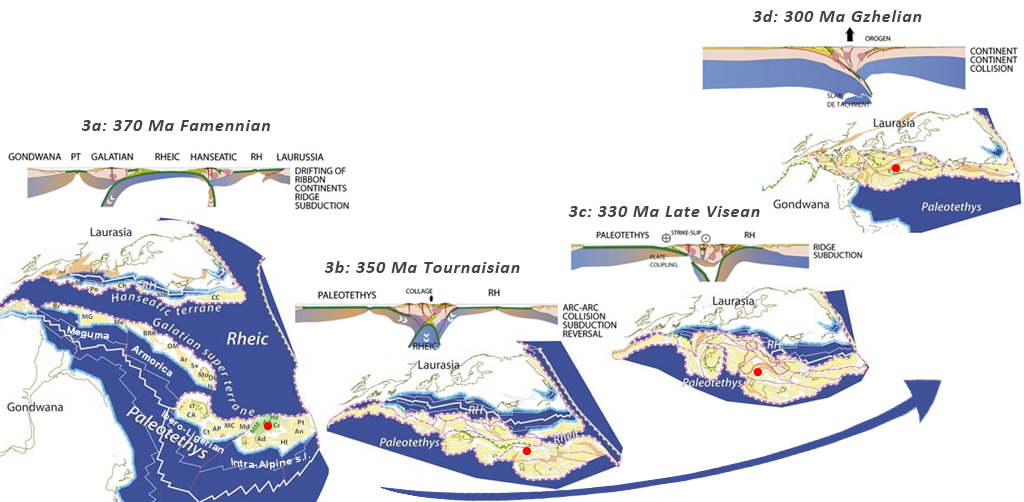
Fig. 3: Late Devonian to Late Carboniferous drift hystory of the Galatian Superterrane, originally termed Greater Galatian Superterrane (Stampfli et al., 2008). comprising four sub-terranes: Meguma, Armorica, Ibero-Ligerian and Intra-Alpine sensu lato. The scope and position of the Intra-Alpine terrane sensu stricto (= basement areas of the present-day Alps (Helvetic, Penninic, Austoalpine and Southalpine), Montagne Noire-Maures and Carpathians) highlighted in green (only 3a). The Intra-Alpine terrane sensu lato comprises Intra-Alpine s.str. + south- and eastward exposed basement units , e.g. Dinaridic, Sardinian, Hellenidic, Anatolic and Pontidic. Approximate position of the Carnic Alps and Southern Karavanks indicated by red dot (Slightly modified after Stamfgli et al., 2011; von Raumer et al., 2013).
2: According to the second model, the present-day Variscan Europe, i.e., south of the Avalonian crust (Greater Galatian or Hunic superterrane), remained an integral part of the northern Gondwanan margin throughout the Paleozoic until the collision of Gondwana with Laurussia in the Late Carboniferous. This implies that the Palaeotethys ocean never came into existence or existed only as a narrow ephemeral sea.
In either scenario, the closure of the Rheic Ocean in the Carboniferous culminated in its western domain in the Variscan orogeny (von Shonlaub & Histon, 1999; 2000; Tait et al., 2000; Schatz et al., 2002; Schatz, 2004; Raumer & Stampfli, 2008; Nance et al., 2012; von Raumer et al., 2013, Stampfli et al., 2002; 2011; 2013) accompained by light grade metamorphism and deformation of the Prevariscan sequence (Schonlaub & Forke, 2007; Forke et al., 2006; Brime et al., 2008, Corradini et al., 2015; 2017; Hubmnann et al., 2014).
The Prevariscan basement of the Carnic Alps and Southern Karavanks is considered part of the external belt of the European Variscides (Mader & Neubauer, 2004), which was subsequently extensivelly deformed by the collisonal tectonics that gave rise to Alps (Fig. 4).
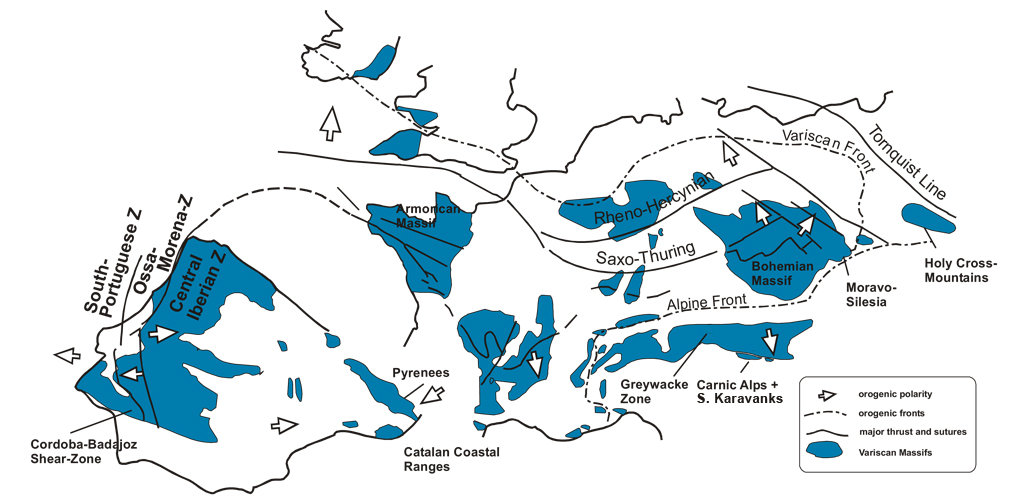
Fig. 4: Structural map of the European Variscan fold belt, excluding blocks of southeastern Europe e.g. the Hellenidic, Dinaridic and Pontidic. After Schaetz, 2004.
According to Frisch & Neubauer (1989), the Prevariscan units of the Southern Karavanks were deposited on the consolidated shelf of the Noric terrane = Noric Composite Terrane, comprising all pre-early Late Carboniferous fossililiferous sequences of the eastern Southern Alps (exposed in the Southern Karavanks and Carnic Alps) and Upper Australpine (exposed in the Greywacke Zone, Gurktal Nappe, Nötsch Carboniferous, Graz Palaeozoic and isolated outcrops in Southern Styria and Burgenland) (Neubauer & Handler, 1999; Schaetz, 2004; Tait et al., 2000; Mader & Neubauer, 2004). The Noric Terrane, also termed Noric-Bosnian Zone (Flugel, 1990), Noric-Bosnian Terrane (Nubauer & Raumer, 1993; Neubauer & Handler, 2000), when expanded to include various Dinaric and Carpathian units with similar depositional history, represents one of the Proto-Alpine (Schaetz et al; 2002, Schaetz 2004) or Intra-Alpine (Stampfli, 1996) terranes (not to be confused with Proto-Alps or Intra alpine terrane as a whole) forming Prevariscan basal units of the present day European Alps. The Noric sequences (fig. 4) document late Ordovician crustal thinning and rifting at the northern Gondwanan margin and deposition in a back-arc setting, followed by the Silurian to Devonian formation and Early Carboniferous destruction of the passive continental margin as the Noric terrane collided (Neubauer & Handler, 2000; Neubauer et al., 1999) in the Early Carboniferous with other Proto-Alpine terranes successively accreted onto the southernh margin of Laurussia (by then including terranes accreted in the Silurian-Devonian e.g. Avalonia, Armorican asseblage) throughout the Devonian-Early Carboniferous (Tait et al., 2000). The Proto- or Intra-Alpine terrane-assemblage was considered part of the vast ribbon-like composite Hunic terrane by Stampfli et al. (2002) or Greater Galatian Superterrane (von Raumer & Stampfli, 2008) described as having collided with Laurussia and the peri-Laurussian Hanseatic terrane respectively. (von Raumer et al., 2002) (Frisch & Neubauer, 1989; Neubauer & Handler, 2000; Neubauer et al., 1999, Stampfli, 1996; Stampfli et. al., 2002; Schaetz, 2004; Tait et al., 2000; von Raumer et al., 2002; Stampfli et al., 2002; von Raumer & Stampfli, 2008). The composite basement of Noric terrane fomed by ammalgamtion of the preexisting Celtic and Speik terranes is covered by the Late ordovician – Early Carboniferous sequence deposited on a consolidated shelf showing continuous deepening (Frisch & Neubauer, 1989) further accelerated due to seafloor-spreading-related thermal subsidence at the mature passive margin and/or subduction of the plate approaching the subduction zone (see below) (Stampfli, 1996; von Raumer et al., 2013; Stampfli et al., 2013).
Faunal and lithological evidence supports the northern Gondwanan position of the Noric terrane throughout the Cambro-Ordovician, with paleomagnetic data indicating continuous drifting from 47° S in the Silurian to an equatorial belt in the Permian, reflected in faunal affinities and the lithologic record (Schaetz, 2004). Following the rifting initiation in the Late ordovician, evidenced by bimodal volcanism in the western Carnic Alps (Hubich et al., 1999), the Prevariscan sedimentary sequence of the Southern Karavanks showcases the typical evolution of a passive continental margin with advancing extensional tectonics reaching its peak during the upper Late Devonian to lower Early Carboniferous (Diener, 2002). The sequence witnessed neritic limestones and shallow marine shales depositing on the rift-basin floor throughout the Late Ordovician, followed by Silurian to Middle Devonian pelagic limestones and deep marine shales including tuffs (Hubmann, 2014). As the shelf of the northward-drifting Noric terrane entered the subtropical belt (31° in the Middle and 25° in the Late Devonian (Schaetz, 2004)), environmental conditions began favoring reef growth and carbonate platform formation. Pelagic sedimentation persisted into the Early Devonian, prevailing until the late Emsian when shallow and deep-marine facies belts evolved over short distances in a differentially subsiding basin affected by synsedimentary extensional tectonics. Various subsidence rates, coupled with low sedimentary rates offshore and the condensation of pelagic deposits, resulted in significant thickness differences between proximal and distal units (Kreutzer et al., 1997; Schonlaub & Histon, 1999, 2000; see Humbann et al., 2014 for thickness of individual units). Thick reef and near-reef sediments transitioned basinward into relatively thin pelagic cephalopod-limestones, shales, and cherts. An extensive carbonate platform was established in shallow marine settings, persisting until the late Frasnian. The several hundred meters thick platform succession comprises carbonate buildups featuring core and reef-flat facies dominated by tabulate corals, stromatoporids, and green algae Renalcis. These facies interfinger with forereef pack- and rudstones, consisting of fragmented core-building organisms, and with backreef limestones, including algal bindstones containing sedimentary structures indicating inter- and supratidal environments (Rantitsch, 1992; McCann et al., 2008). Based on the local occurences of volcaniclastic material within the middle Devonian part of the complex, closely spaced facies belts, and supposed inter-reef mudstones suggesting sedimentation between discrete reef-bodies, the reefal structures of the Southern Karavanks have been likened to present-day atolls, contrasting with the coeval barrier-type reefs of the Carnic Alps (Rantitsch, 1992; McCann et al., 2008, Schonlaub, 2013 and references therein). In both the Southern Karavanks and Carnic Alps, synsedimentary extensional tectonics at the passive continental margin led to a basin collapse, causing drowning and the cessation of reef growth by the late Frasnian. This was followed by uniform pelagic sedimentation of condensed cephalopod-bearing limestones and radiolarian cherts (lydites) continuing across the Devonian-Carboniferous border and lasting up to the lowermost Visean (Schonlaub, 1992; Schonlaub & Histon, 1999; 2000; Ebner et al., 2010; Corradini et al., 2012, 2017). Similar pelagic sequences are widespread throughout the Galatian Superterrane, reflecting thermal subsidence of the blocks detached from the northern Gondwanan Margin before their collision with the southern margin of the Hanseatic terrane, heralded by Tournaisian/Visean olistolith-bearing flysch sedimentation (von Raumer et al., 2013; Stampfli et al., 2013). The Late Devonian/Early Carboniferous deepening might also be related to flexure of the underriding plate approaching the subduction zone (Stampfli, 1996). As the geodynamic conditions changed in the Early Carboniferous from passive margin dominated by extensional tectonics to an active one, flexure of the underriding plate, in response to its entry into the subduction zone, caused a slow rise of surface seaward of the trench in a feature known as a forebulge (Schonlaub & Histon, 1999, 2000; Forke et al., 2006; Schonlaub & Forke, 2007) . The formation of the forebulge south of the incipient subduction zone resulted in relative sea level drop leading locally to karstification and erosion/non-deposition across the Devonian/Carboniferous boundary. The subaerial erosional gaps and paleorelief features spanning the Frasnian - late Tournasian/early Visean interval can be observed in the goniatite-clymmenid bearing pelagic limestones and even atop the underlying reefs (Tessensohn 1974; Schönlaub et al. 1991; Forke et al., 2006; Schonlaub & Forke, 2007; Ebner et al., 2008, McCann et al., 2008; Pondrelli et al., 2014). This has also been attributed to global glacial eustatic sea-level fluctuations at the Devonian-Carboniferous transition, but given the spatialy-confined nature of the phenomena, synsedimentary tectonics was probably a major factor (Ebner et al., 2008). The continous north-directed subducion lead to a diachronous flysch-like sedimentation of the 2000 m thick clastic Hochwipfel Formation of younger Visean to younger Moscowian age, marking the onset of the Variscan orogenic events in the eastern Carnic Alps and Southern Karavanks. (Hubich et al., 1999; Laufer et al., 2001; Deiner, 2002; Forke et al, 2006; Schonlaub & Forke, 2007). Older Ordovician to Early Carboniferous sediments incorporated into the accretionary wedge during the ongoing subduction were redeposited as olistolithes during rapid turbidite, gravity mass flow, and slump sedimentation (Diener, 2002) in the deeping trench (Hubich et al., 1999; Laufer et al., 2001; Forke et al, 2006; Schonlaub & Forke, 2007). The rapidly subsiding sedimentary basin is interprented by Diener (2002) as a pull-apart basin at the strike-slip continental margin.
Postvariscan Evolution (Late Carboniferous- Permian/Triassic boundary)
The Postvariscan i.e. late to post-orogenic succession (Late Carboniferous-Late Permian) of the Southern Karavanks, is comprised of two transgressional phases (tectono-sedimentary cycles), separated by an unconformity resulting from a phase of uplift and erosion.
The first cycle (Late Carboniferous - Early Permian)
The deformed Prevariscan basement, including the synorogenic sediments of the Hocwipfel Formation, is overlain in the eastern Carnic Alps and Southern Karavanks by the lowermost cycle, consisting of deltaic and shallow marine siliciclastic and carbonate sediments deposited in discrete basins formed by block-and-wrench faulting after the final phase of the Variscan Orogeny (McCann et al., 2008 and references therein).
The Late Carboniferous-Early Permian sedimentary evolution of both regions is characterized by a gradual shift of depositional settings, transitioning from mixed siliciclastic-carbonate sedimentation on a coastal to shallow-marine ramp setting (Auernig Fm) to open marine conditions with predominantly carbonate sedimentation (Rattendorf Group), culminating in a carbonate succession deposited on a rimmed shelf margin (Trogkofel Group) at the fringes of the Western Palaeo-Tethys. However, starting from the Early Asselian and at least up to the Late Sakmarian, the sedimentary evolution of the central Southern Karavanks followed a different path (as detailed below).
The first cycle (Late Carboniferous-Early Permian) and indeed, the entire post-Variscan sequence of the eastern Carnic Alps commenced with the Collendiaul Formation, overlying the pre-Variscan basement with an erosional unconformity caused by the Variscan uplift. Lydite breccias and conglomerates of the Collendiaul Formation, resulting from the erosion of the uplifted area , lack known exposures in the Southern Karavanks, hence the succession in that region commences with alternating fluvio-deltaic siliciclastic and shallow marine deposits of the Auernig Formation. (Forke et al, 2006; Schonlaub & Forke, 2007; Novak, 2007). The cyclic silicilastic-carbonate sedimentation-pattern has been largely attributed to glacioeustatic sea level oscilations (Massari & Venturini, 1990; Massari et al., 1991; Venturini 1990b; Krainer, 1991; 1992, Samankassou, 1997). Predominantly calcareous intervals mirror sea-level highstands with warmer average water temperatures promoting carbonate production. Conversely, lowstands with cooler average water temperatures hindered carbonate production, leading to deposits dominated by siliciclasts (Samankassou, 1997). The carbonate horizons primarily consist of indistinctly bedded to massive limestones, representing fossilized dasycladacean mounds that thrived during transgressive-highstands. According to Buttersack & Boeckelman (1984), the controlling factor of algal growth was a variable siliclastic input associated with different rates of basinal subsiding: periods of intense subsidence led to high detrital influx, suffocating algal growth, and vice versa, resulting in alternating siliciclastic and calcareous horizons.
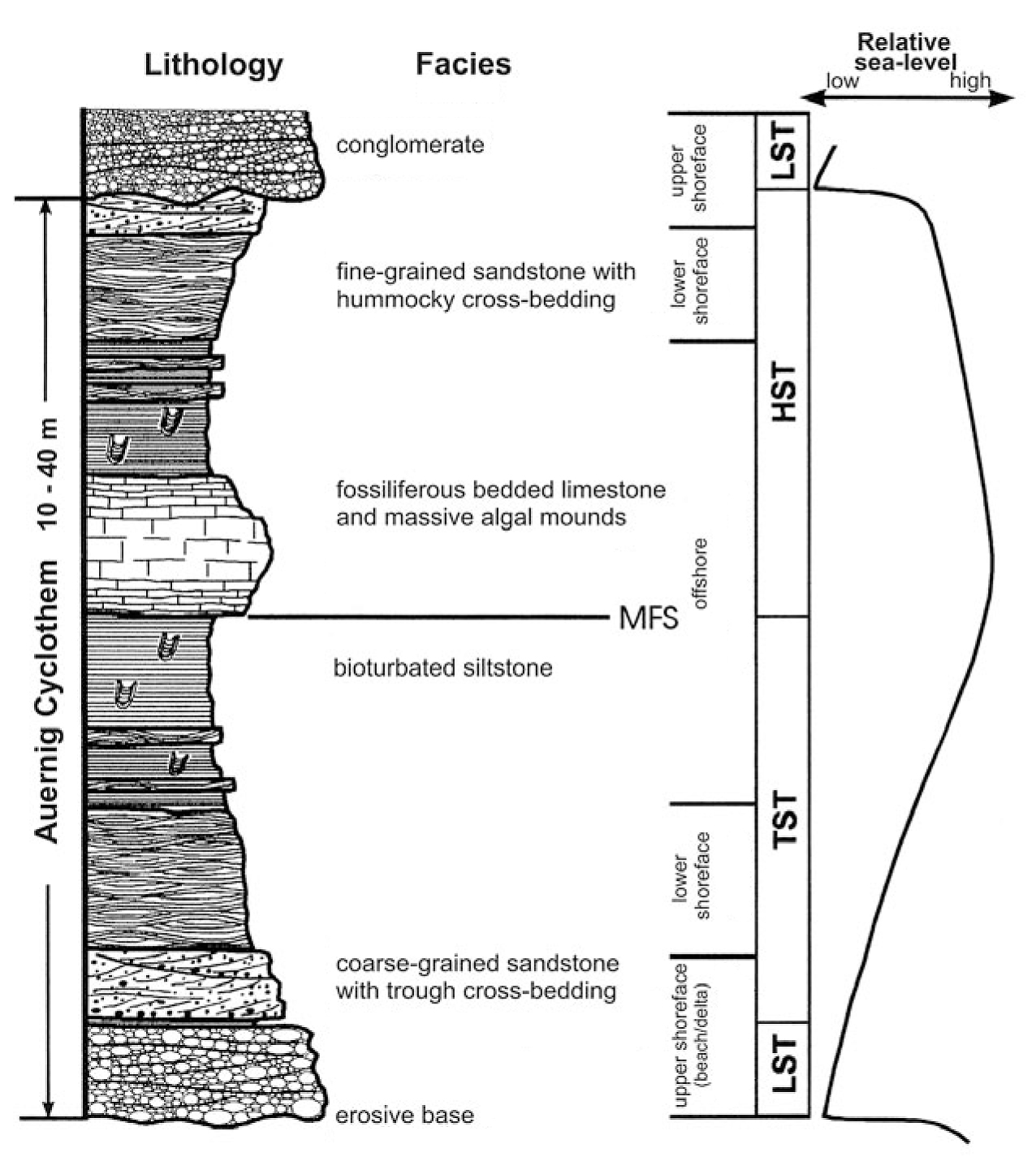
Fig.5: Idealized Auernig cyclothem from the upper part of the Auernig Formation (after Krainer & Davidov, 1998).
The cyclical pattern persisted across the Carboniferous-Permian border, characterized by an overarching transgression trend that featured more stable marine conditions, evidenced by the predominantly calcareous facies observed in the Rattendorf Group formations (Forke, 2002; Corradini et al., 2012).
The carbonate-dominated Schulterkofel Formation in the Carnic Alps comprises four cyclothems, each commencing with a thin siliclastic horizon deposited in a nearshore environment during relative sea level lowstands. These siliclastics transition upwards into bedded fossiliferous and massive algal limestones accumulated during the transgressions. The massive limestones, representing dasycladacean mounds, are often capped by cherty limestones (referred to as "shroud facies"), indicating the cessation of algal growth due to drowning during sea level highstands (Samankassou, 1999; Forke, 2002; Samankassou, 2003; Novak, 2007; Kido et al., 2012). In stark contrast to the primarily calcareous Schulterkofel Formation of the Carnic Alps, the majority of coeval exposures in the Southern Karavanks exhibit siliciclastic-dominated lithofacies (Novak, 2007). This suggests that diachronous sedimentation of the Aeurnig Formation, extending in the Southern Karavanks into the uppermost Gzhelian, temporally overlaps with the Schulterkofel Formation of the Carnic Alps. Typical carbonate-dominated beds with shroud-veiled algal mounds are found at a singular exposure (preserving 1.5 cyclothems) in the central Southern Karavanks (Forke, 2002; Novak, 2007).
By the Asselian stage, the sedimentary evolution of the central and western Southern Karavanks diverged, with the latter sharing a common depositional history with the Carnic Alps. In the Carnic Alps area, the primarily calcareous Rattendorf Group is interspersed with the siliciclastic horizon of the Grenzland Formation, deposited in very shallow marine environments periodically exposed to subaerial conditions. This is evidenced by collapse breccias, paleosols, and fractures (Forke et al., 2006; Schonlaub & Forke, 2007). However, the outcrops in the western Southern Karavanks, ostensibly attributed to the Grenzland Formation, are scarce and their association is questionable (Novak, 2007).
During the ongoing deposition of the fossil-barren Grenzland Formation, the central Southern Karavanks apparently formed part of another domain with parallel but distinct sedimentation patterns.
In the middle to late Asselian, the central Southern Karavanks underwent the evolution of a carbonate platform, transitioning from a gently sloping, siliciclastic(?) ramp to a reef-rimmed shelf, evidenced by the Dovžavova Soteska Formation. The lowermost siliciclastic part of the formation grades upwards with an increasing carbonate component into the Dovžanova Soteska Limestone Member, representing a reef mound structure dominated by encrusted skeletal grains embedded in a micritic matrix. This reef mound progressively evolved into a rigid shelf-margin barrier through a series of rapid progradations, alternating with backstep-coupled vertical accretions. The former corresponds to sea-level standstills or slow rises, while the latter indicates rapid rises. Reef growth terminated by subaerial exposure, recorded in the erosional surface atop the Dovžanova Soteska Limestone member, was followed by transgression, which shifted the depositional setting towards an open-marine platform interior protected by ooilitic and sand shoals (= lagoon) and interspersed with rugose coral patch reefs. The calcareous-silicilastic open lagoon deposits, grouped into the Born Formation are in buried fault-contact with the Rigelj Formation reflecting gradual seaward shift of facies belts, followed by a landward one. Depositional setting shifted from transitional coastal (clastic rocks), through inner-platform (algal limestones interbedded with clayshale) with restricted (low algal-diversity) and open marine conditions (high diversity), towards platform edge belt (reef limestones and limestone breccias), and vice versa. (Forke, 2002; Novak, 2007; Novak & Skaberne, 2007; Novak 2009; Novak & Krainer, 2022).
The differences observed in the Early Permian lithologic successions between the Carnic Alps/western Southern Karavanks (Grenzland Fm) and the central Southern Karavanks (Dovžanova Soteska Fm, Born Fm, Rigelj Fm) may reflect lateral facies variations in the Southern Alps, or the latter might even represent an independent tectonic unit (Forke, 2002).
The siliciclastic input characterizing the mid-part of the Rattendorf Group (Grenzland Formation) decreased by the time of the Zweikofel Formation, predominantly deposited in carbonate inner-shelf environments with high-energy ooid barriers (Schonlaub & Forke, 2007; Krainer et al., 2009; Novak & Skaberne, 2009; Hubman et al., 2014).
In the Late Artinskian, sedimentation of the Trogkofel Group commenced. The depositional cyclicity, typical of the Auernig Formation and to a lesser degree of the Rattendorf Group, ceased, yet the sea-level fluctuations presumably recorded by multiple phases of karstification and subaerial exposure surfaces may have continued into the Trogkofel limestone (Krainer et al., 2009). The carbonate succession of the Trogkofel Formation indicates a platform-reef-slope geometry. Its lithofacies types comprise dominant massive limestones representing shelf-margin skeletal-microbial-cement reefs, bedded dasycladacean- and fusulinid-containing limestones deposited on the platform behind shelf-margin reefs, and upper slope deposits (breccias) (Schonlaub & Forke, 2007; Hubmann et al., 2014; Schaffhauser et al., 2015). Downfaulting-induced landward shifts of facies belts (backstep) led to the juxtaposition of unbedded shelf-margin-buildup limestone atop bedded platform limestones (Krainer et al., 2009). Deposition of the Trogkofel Formation was terminated by uplift related to a transpressional ("Saalian") tectonic phase, resulting in subaerial truncation and karstification (Corradini et al., 2012; Schaffhauser et al., 2015).
The emersion and subsequent erosion produced coarsely clastic rocks given various names (i.e., Tarvis breccia, Trogkofel conglomerate/breccia), depending on their lithology and underlying basement (see Schonlaub & Forke, 2007; Hubmann et al., 2014). They supposedly represent rudite horizons derived from the Trogkofel limestone, although their composition varies, and their stratigraphic position remains unclear.
The second cycle (Middle - Late Permian)
Sedimentation of the continental rudite deposits, regulated by the newly commenced transpressional tectonic phase, was followed by marine to terrigenous Gröden Formation, deposited in fluvial, playa, and shallow water environments, and finally, by the basal evaporitic, lagoonal, and shallow marine sediments of the Bellerophon Formation indicating a slow rise of sea level (Vozarova et al., 2009; Corradini et al., 2012).


